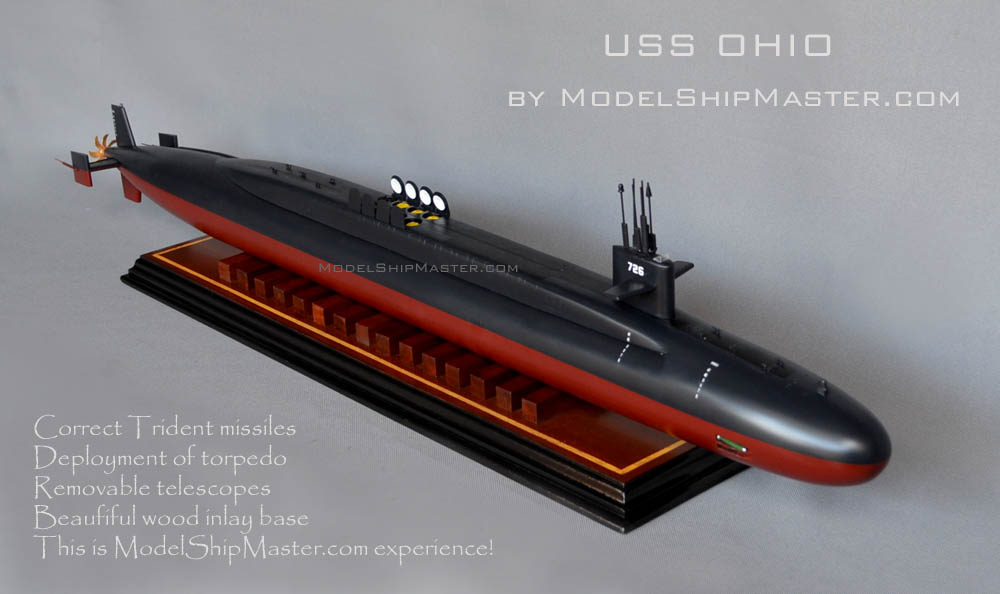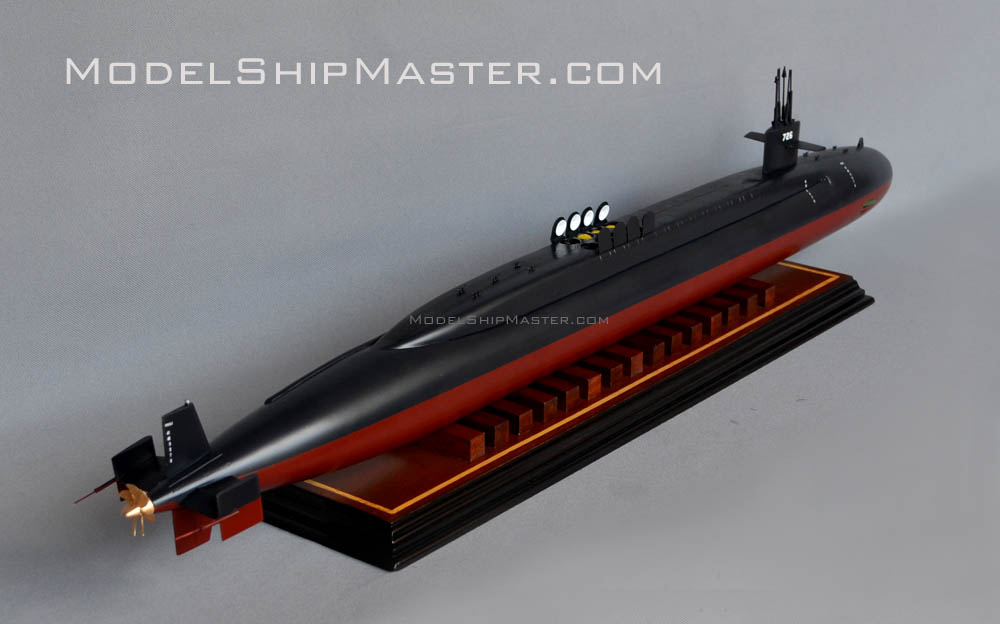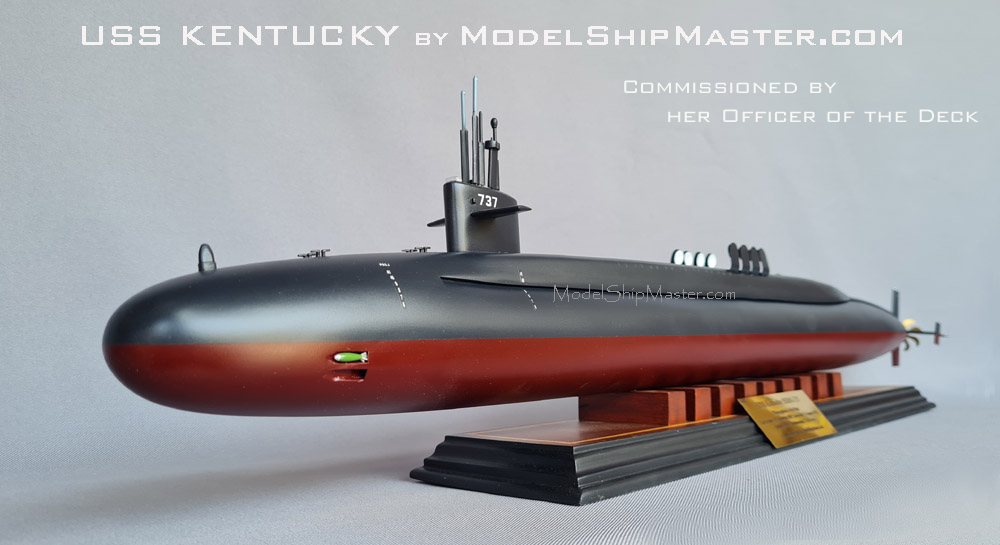|


256-bit encryption
$500,000 protection

|
OHIO Class Submarine
model
The Ohio class submarines
includes the United States Navy's 14 ballistic missile
submarines (SSBNs) and four cruise missile
submarines (SSGNs). Each displacing 18,750 tons
submerged, the Ohio-class boats are the largest
submarines ever built for the U.S. Navy. Only the
Russian 48,000-ton Typhoon class and 24,000-ton Borei
class are larger than Ohio subs.
Smaller doesn't mean inferior. In fact,
it's superior in this case, as the
Ohio class carry more missiles than those Russian: 24 Trident
II missiles apiece, versus 16 by the Borei class (20 by
the Borei II) and 20 by the Typhoon class.
These
24 ballistic missiles with MIRV warheads that can be
accurately delivered to targets from anywhere in the
world's oceans.
Also, the USS
Ohio was undetectable in her sea trials in
1982.

A streamlined (fish-shaped) outer
hull permits the Ohio submarines to move quietly
through the water at high speeds. The hull
was designed specifically for efficient cruising
underwater; the
Skipjack was the first nuclear-powered ship to
adopt this hull form.
The Ohio-class submarines
are specifically designed for extended deterrent
patrols. Each Ohio class sub is assigned two complete crews,
called the Blue crew and the Gold crew, each typically
serving 70-to-90-day deterrent patrols. To increase the
time in port for crew turnover and replenishment, three
large logistics hatches are fitted to provide large
diameter resupply and repair openings. These hatches
allow sailors to rapidly transfer supply pallets,
equipment replacement modules and machinery components,
significantly reducing the time required for
replenishment and maintenance. Each SSBN is at sea at
least 66 percent of the time, including major overhaul
periods of twelve months every nine years. One SSBN
combat employment cycle includes a 70-day patrol and
25-day period of transfer of the submarine to the other
crew, between-deployment maintenance, and reloading of
munitions.

SSBN/SSGN conversions:
In 1994, the Navy determined that, of the 18 Ohio class SSBNs
the U.S. Navy would be operating in total, 14 would be
sufficient for the strategic needs of the U.S. The
decision was made to convert four Ohio-class subs into SSGNs capable of conducting conventional land attack and
special operations. As a result, the four oldest boats
of the class—Ohio, Michigan, Florida, and
Georgia—progressively entered the conversion process in
late 2002 and were returned to active service by 2008.
The boats could thereafter carry 154 Tomahawk cruise
missiles and 66 special operations personnel, among
other capabilities and upgrades. The cost to refit the
four boats was around $1 billion (2008 dollars) per
vessel.
The conversion modified 22 of the 24 88-inch (2.2 m)
diameter Trident missile tubes to contain large vertical
launch systems, one configuration of which may be a
cluster of seven Tomahawk cruise missiles. In this
configuration, the number of cruise missiles carried
could be a maximum of 154, the equivalent of what is
typically deployed in a surface battle group. Other
payload possibilities include new generations
of supersonic and hypersonic cruise missiles, and
Submarine Launched Intermediate Range Ballistic
Missiles, unmanned aerial vehicles, the ADM-160 MALD,
sensors for antisubmarine warfare or intelligence,
surveillance, and reconnaissance missions, counter mine
warfare payloads such as the AN/BLQ-11 Long Term Mine
Reconnaissance System, and the broaching universal
buoyant launcher and stealthy affordable capsule
system specialized payload canisters.The missile tubes
also have room for stowage canisters that can extend the
forward deployment time for special forces. The other
two Trident tubes are converted to swimmer lockout
chambers. For special operations, the Advanced SEAL
Delivery System and the dry deck shelter can be mounted
on the lockout chamber and the boat will be able to host
up to 66 special-operations sailors or Marines, such
as Navy SEALs, or USMC MARSOC teams. Improved
communications equipment installed during the upgrade
allows the SSGNs to serve as a forward-deployed,
clandestine Small Combatant Joint Command Center.

During conversion, each Ohio class
submarine SSGN received the
Common Submarine Radio Room and two High-Data-Rate
antennas for significantly enhanced communication
capabilities. These additions allow each SSGN to serve
as a forward-deployed, clandestine Small Combatant Joint
Command Center.
Combined, the four SSGNs represent more
than half of the Submarine Force’s vertical launch
payload capacity with each SSGN capable of carrying up
to 154 Tomahawk land-attack cruise missiles. The
missiles are loaded in seven-shot Multiple-All-Up-Round
Canisters (MACs) in up to 22 missile tubes. These
missile tubes can also accommodate additional stowage
canisters for SOF equipment, food, and other consumables
to extend the submarines’ ability to remain forward
deployed in support of combatant commander’s tasking.
The missile tubes are also able to accommodate future
payloads such as new types of missiles, unmanned aerial
vehicles, and unmanned undersea vehicles.
On
September 6th, 1997, Naval Submarine Base Kings Bay
hosted the commissioning of USS LOUISIANA (SSBN 743),
completing the Navy's fleet of 18 fleet ballistic
missile submarines. The ten Trident submarines in the
Atlantic fleet were initially equipped with the D-5
Trident II missile. The eight submarines in the Pacific
were initially equipped with the C-4 Trident I missile.
In 1996 the Navy started to backfit the eight submarines
in the Pacific to carry the D-5 missile.
Ohioclass guided-missile
submarines (SSGN) provide the Navy with unprecedented
strike and special operation mission capabilities from a
stealthy, clandestine platform. Armed with tactical
missiles and equipped with superior communications
capabilities, SSGNs are capable of directly supporting
Combatant Commander’s strike and Special Operation
Forces (SOF) requirements.

We build this primarily wood Ohio class submarine model
in two sizes:
-
47" long (1/144 scale)
$4,200 Shipping and insurance in
the contiguous USA included.
Other places: $350 flat rate.
-
34" long (1/200 scale) x 8.5" tall x 5" wide
$2,470 Shipping and insurance in
the contiguous USA included.
Other places: $250 flat rate.
- 19" long (1/350 scale)
$1,715 Shipping and insurance in
the contiguous USA included.
Other places: $200 flat rate.
These models are
built per commission only. We require only a small
deposit to start the process $500  The
remaining balance won't be due until the model is
completed, in 3-4 months. The
remaining balance won't be due until the model is
completed, in 3-4 months.
For different sizes,
contact us for a quote:
Services@ModelShipMaster.com.

Compare this model against the others on the Internet to
see how superior our
Ohio class submarine
model is. We not only have the highest number of
submarine models but also possess the accuracy level
that is far more than any other builders'. 100% money back guarantee if
you can spot a better scratch-built
Ohio class
submarine. No restocking fee, no questions
asked.
If you think you've
found a model that is better than ours, go here for
a reward.
ModelShipMaster.com builds any
submarine models, at virtually any sizes. When you are choosing
a reputable builder for your favorite submarine,
look for large photos showing details to verify if a
model is worth the title "museum quality" as wildly
claimed by some. Do not assume a model that looks
good from far away (in smaller photos) is actually good.
It's the accuracy and craftsmanship that count and only
large photos can tell you that.
Learn more about the Ohio class submarine here:
https://en.wikipedia.org/wiki/Ohio-class_submarine
|